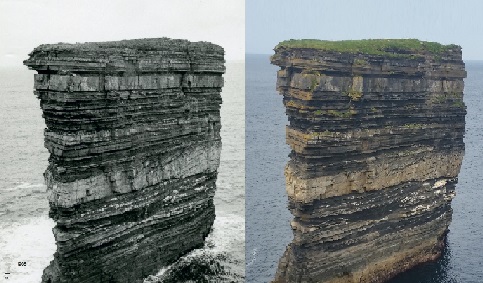Dun BristeDun Briste is a truly incredible site to see but must be visited to appreciate its splendour.Dún Briste (Gaelic for Broken Fort) was once joined to the mainland. The sea stack stands 45 metres (150 feet) tall.
|
|
Dun Briste and the surrounding cliffs were formed around 350 million years ago (during the 'Lower Carboniferous Period'), when sea temperatures were much higher and the coastline at a greater distance away. There are many legends describing how the Sea Stack was formed but it is widely accepted that an arch leading to the rock collapsed during very rough sea conditions in 1393. This is remarkably recent in geological terms.
|
Click on the image for a higher resolution. Incredibly, some loose rocks located at the top left of the 1968 photograph are still there 47 years later. The 1968 image is taken from the book 'The Road to Downpatrick' by Donal McCormick.
A large piece of rock at the top right of the image (approximately 4 meters square) has broken away. Amazingly, this event was witnessed and the resulting splash photographed by Olivier Lerebourg which can be viewed here. |




